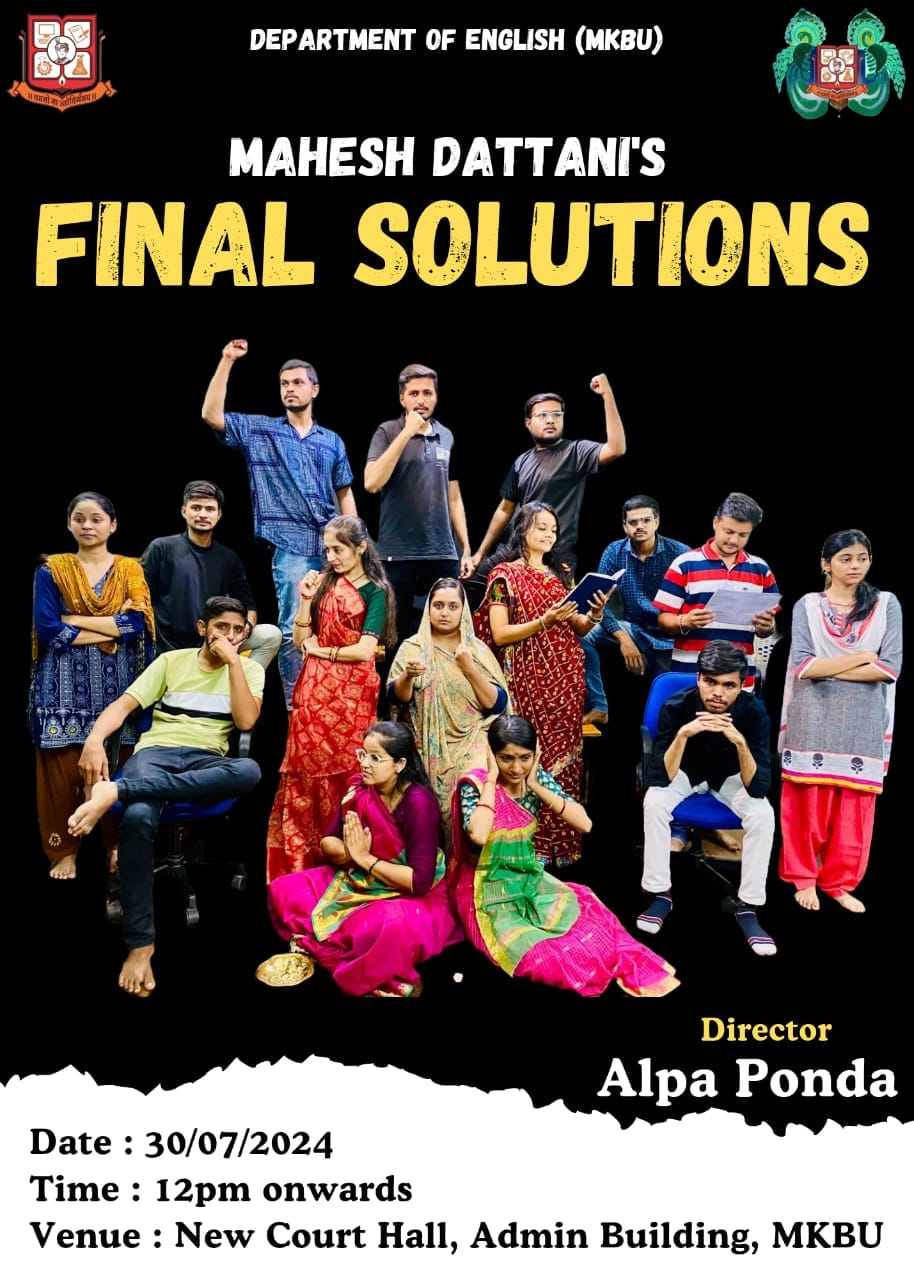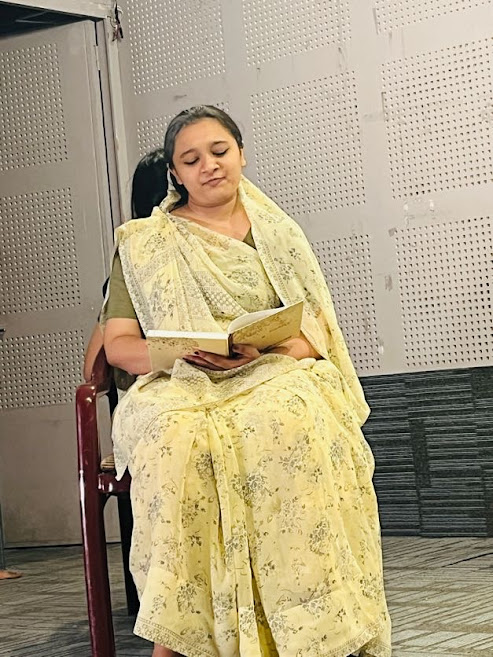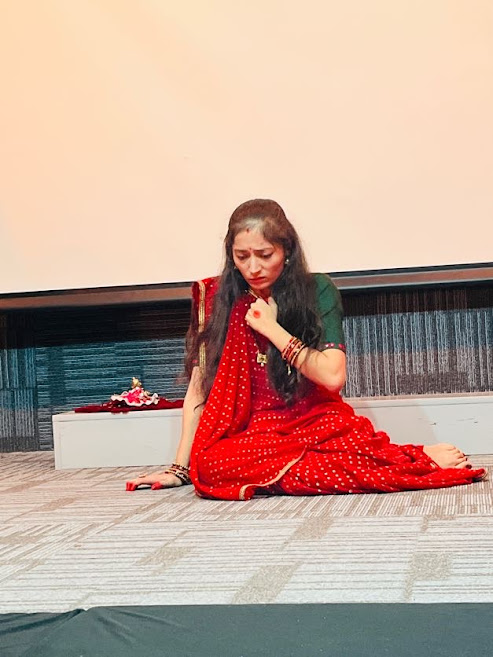Mahesh Dattani's Final Solutions
Hello. This blog is assigned by Prakruti ma'am for the paper 202- Indian English Literature Post-Independence, unit 3. This is a reflective blog in which I will share my experience of attending a drama workshop conducted by research scholar Alpa Ponda ma'am, who is pursuing her Ph.D. in "Drama Pedagogy" in the literature classroom, on the drama "Final Solution" by Mahesh Dattani, 1993. Afterward, I will address critical questions about the same drama.
Mahesh Dattani’s Final Solutions is a rich tapestry of emotional intensity, cultural conflict, and psychological depth. As a student of theatre, my experience of reading, studying, rehearsing, and performing the play has been transformative. Through its innovative manipulation of time and space, and its exploration of guilt, the play becomes more than a simple story of communal tensions—it becomes a broader meditation on the human experience and a compelling examination of history's lingering wounds. This blog will reflect on that journey while addressing three key questions: Dattani’s use of time and space, the complex emotions of guilt experienced by the characters, and my personal journey through the process of studying and performing the play.
- How does Mahesh Dattani manipulate time and space within the dramatic framework of Final Solutions to create meaning? Explore the interplay of these elements with specific reference to the stagecraft techniques employed by the playwright.
Reflecting on the experience of reading and performing *Final Solutions* by Mahesh Dattani offers deep insight into how the playwright manipulates time and space to create layered meanings. Dattani’s approach to these elements is intricate, as they serve not only to tell the story but also to evoke the emotional and psychological depth of the characters and their social circumstances.
Manipulation of Time
Dattani uses a non-linear structure that allows for an exploration of both the past and present, blurring the lines between the two. In performance, this manipulation creates a sense of fluidity in time, where past traumas and conflicts are not distant memories but active influences on the present. For example, the play frequently shifts between the events of a past riot and the contemporary communal tensions faced by the characters. This temporal overlap highlights how unresolved historical grievances perpetuate present conflicts.
During performance, these shifts in time might be subtle, marked by changes in lighting or the use of sound effects to indicate a flashback. The characters’ interactions are often laced with echoes of their past experiences, and these flashbacks allow the audience to witness how the past directly shapes the characters' motivations and fears. The use of flashbacks ensures that the audience is constantly aware of the cyclical nature of communal hatred, reinforcing the idea that the past is never truly past—it continually haunts the present.
Manipulation of Space
Dattani's manipulation of space is similarly significant. The set in *Final Solutions* is often minimalistic, with different locations represented symbolically rather than realistically. This abstract representation of space allows for multiple realities to coexist on stage. For instance, different spaces—like the Hindu home and the streets where riots take place—are often represented simultaneously. This forces the audience to confront the parallel existence of safety and danger, comfort and conflict, without the comfort of spatial separation.
In performance, this spatial fluidity is amplified by the rotating stage, which physically moves the characters between different spaces, symbolizing the shifting dynamics of their relationships and the instability of their world. The transition between spaces is often seamless, further emphasizing the interconnectedness of different realms, whether it’s the inner sanctum of the home or the chaotic public spaces of the community.
Stagecraft Techniques
Several stagecraft techniques contribute to the effective manipulation of time and space in the play:
- The Chorus: The use of a Chorus, representing the collective voice of society, is a powerful device in *Final Solutions*. The Chorus transcends specific temporal and spatial boundaries, embodying the persistent societal pressures and prejudices that are ever-present, regardless of the setting. The Chorus often speaks directly to the audience, creating a sense of immediacy and timelessness that bridges the gap between past and present.
- Lighting: Lighting in *Final Solutions* plays a crucial role in demarcating different times and spaces. Specific lighting cues signal shifts in time, while certain areas of the stage may be illuminated or darkened to represent changes in location or mood. For instance, warm lighting might signify the safety of the home, while harsh, cold lighting might represent the violence of the outside world.
- **Props and Set Design**: Dattani’s use of minimal props and set pieces allows the audience to focus on the emotional and psychological landscapes of the characters. The sparse set becomes a canvas upon which different realities are projected, depending on how the actors move and interact with their environment.
Creating Meaning
Through these manipulations of time and space, Dattani creates a narrative that is both immediate and reflective. The collapsing of temporal boundaries suggests that communal tensions are not isolated incidents but part of an ongoing historical continuum. Similarly, the blending of spaces underscores the pervasiveness of communalism, infiltrating every aspect of life, from the personal to the political.
In performance, these elements draw the audience into the emotional heart of the play, allowing them to experience the characters’ inner turmoil while also considering the broader social and historical implications. This interplay of time, space, and stagecraft not only drives the narrative forward but also deepens the audience's understanding of the characters' psychological states and the societal forces at play.
In summary, Mahesh Dattani masterfully manipulates time and space in *Final Solutions* to reflect the complex realities of communal conflict, creating a multi-dimensional experience that resonates deeply both in reading and performance.
- Examine the complexity of guilt experienced by the characters in the play. How does this emotion shape their actions and relationships?
In *Final Solutions*, the complexity of guilt plays a pivotal role in shaping the characters' actions and relationships. Mahesh Dattani explores how guilt, often stemming from past communal violence and personal biases, drives the internal and external conflicts of the characters, affecting their interactions with each other.
1. Daksha/Hardika
- Guilt from the Past: Hardika (as a young Daksha) carries the guilt of feeling complicit in the communal violence that impacted her family. Her feelings of betrayal and unresolved anger towards Muslims shape her present-day views, fueling her resentment towards the community.
- **Effect on Relationships**: Her guilt manifests in her strained relationship with her daughter-in-law, Smita, and her suspicion towards the two Muslim boys seeking shelter. Her guilt has hardened into prejudice, making it difficult for her to reconcile with the idea of forgiveness or understanding.
2. Ramnik Gandhi
- **Inherited Guilt**: Ramnik, the head of the Gandhi household, is burdened by the knowledge that his family profited from the communal violence years ago. His guilt over benefiting from the misfortunes of Muslims leads him to act with kindness towards the Muslim boys, trying to make amends for his family’s past wrongdoings.
3. Aruna
- **Religious Guilt**: Aruna feels guilt related to her religious beliefs and perceived failure to uphold them, especially when faced with the presence of the Muslim boys in her home. Her rigid adherence to purity and tradition creates tension within her, as she grapples with the guilt of possibly betraying her religious values.
- **Effect on Relationships**: This religious guilt creates a barrier between her and her family, particularly her daughter, Smita, who rejects such rigid thinking. It also affects her relationship with the boys, making her hesitant to show compassion, even when they are in need.
4. Smita
- **Guilt of Complicity**: Smita feels guilt over being part of a system that fosters communal hatred, yet she struggles with how to confront this guilt. She is caught between her family’s prejudices and her desire to be more open-minded and just.
- **Effect on Actions**: Her guilt drives her to distance herself from her family’s beliefs, yet she feels powerless to challenge them directly. This creates tension between her and her parents, as she silently disagrees with their actions but is unable to take a stand.
5. Javed
- **Guilt from Violence**: Javed carries the guilt of having participated in communal riots, a choice driven by his own feelings of rejection and anger. This guilt eats away at him, leading him to lash out in frustration and feel like an outsider in both Hindu and Muslim spaces.
- **Effect on Relationships**: His guilt over his past actions affects his relationship with his sister, Bobby, and the Gandhi family. He becomes defensive and angry, struggling to reconcile with his own sense of wrongdoing and trying to justify his actions as necessary for survival.
6. Bobby
- **Guilt of Being an Outsider**: Bobby, though more balanced than Javed, experiences guilt over his inability to bridge the gap between communities. He feels torn between his Muslim identity and the desire for acceptance by the Hindu family sheltering him.
- **Effect on Actions**: His guilt leads him to act as a mediator, trying to de-escalate situations and offer a more moderate perspective. However, it also places him in a difficult position, where he feels the burden of representing his entire community and correcting misconceptions.
Shaping Actions and Relationships
Guilt in *Final Solutions* influences the characters in several ways:
- **Relationships are strained**: The characters’ guilt makes it difficult for them to trust one another or to build meaningful relationships. Whether it’s Hardika’s hardened heart, Aruna’s inability to show compassion, or Ramnik’s struggle to atone for his family’s past, guilt keeps the characters from connecting on a deeper level.
- **Actions are conflicted**: The characters' actions are often motivated by a desire to alleviate their guilt, yet this leads to internal conflict. For instance, Ramnik’s guilt drives him to protect Javed and Bobby, but it also causes him to question his motivations and moral integrity.
- **Guilt perpetuates the cycle of conflict**: Instead of resolving past wrongs, guilt often reinforces the cycle of mistrust and resentment. The characters are trapped by their guilt, unable to move forward or find reconciliation, which mirrors the larger communal tensions in society.
Ultimately, guilt in *Final Solutions* is a central force that shapes the characters' actions and interactions. It complicates their attempts to find peace or closure, showing how deeply embedded emotions like guilt can perpetuate cycles of conflict and hinder healing.
- Reflect on your journey through Final Solutions as a student of theatre. How did the process of studying, rehearsing, and performing this play shape your understanding and appreciation of theatre?
Student of theatre :-It would have been more insightful to discuss the play's themes of racial tension in the community, guilt, and prejudice. Theatre can be a potent vehicle for social commentary. It's captivated by the idea of stage fear, the characters, the background themes, and many more aspects.
Studying :-As I have looked closely at the intricate relationships between the topics, characters, and narrative structure when I read Mahesh Dattani's work. This research may have included delving into the motivations and backgrounds of each character, comprehending the historical and cultural setting of the play, and investigating the play's bigger societal themes, which include identity, guilt, and communal tensions. I observed more about Dattani's use of language and speech to portray the characters' internal problems and external pressures. With its flexible use of time and space and the nonlinear narrative structure, I consider how these components impact how the audience interprets the story.
As I have learnt about Dattani's stagecraft methods such as the use of lighting, set design, and symbolic props to evoke deeper meanings and emotions had I studied Final Solutions. My understanding of the technical aspects of theatre and their role in storytelling would have grown if I had known how these components work in tandem with the script.
Through rehearsing :-Investigated the characters' inner conflicts throughout rehearsals, focussing on how guilt shows up and affects their behaviour. The subtleties of depicting contradictory emotions in which characters struggle with their pasts while attempting to make peace with their present may have been brought to light by this procedure. Personally, I struggled a lot to capture the real expression throughout the play and the essence of emotions, but after a lot of practice, it would be possible. The nonlinear storyline of the play and Dattani's inventive use of space and time will have forced you to consider stagecraft and how these features might be used to improve the storytelling.


























No comments:
Post a Comment